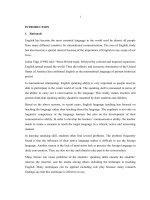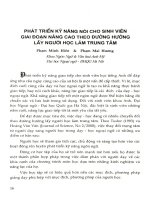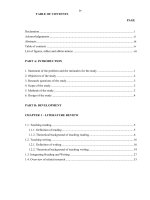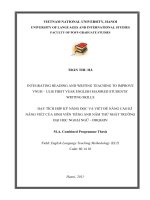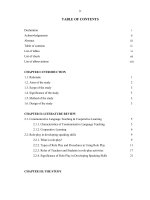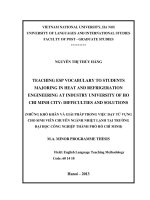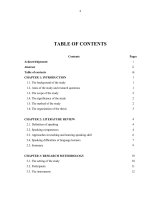Những khó khăn và giải pháp trong việc phát triển kỹ năng nói cho sinh viên tiếng Anh năm thứ 2 hệ vừa làm vừa học Trường Đại học Ngoại ngữ - Đại học Quốc gia H20150227
Bạn đang xem bản rút gọn của tài liệu. Xem và tải ngay bản đầy đủ của tài liệu tại đây (603.93 KB, 46 trang )
4
TABLE OF CONTENTS
Contents
Pages
Acknowledgement
i
Abstract
ii
Table of contents
iii
CHAPTER 1: INTRODUCTION
1
1.1. The background of the study
1
1.2. Aims of the study and research questions
1
1.3. The scope of the study
2
1.4. The significance of the study
2
1.5. The method of the study
2
1.6. The organization of the thesis
3
CHAPTER 2: LITERATURE REVIEW
4
2.1. Definition of speaking
4
2.2. Speaking competences
4
2.3. Approaches in teaching and learning speaking skill
6
2.4. Speaking difficulties of language learners
7
2.5. Summary
9
CHAPTER 3: RESEARCH METHODOLOGY
10
3.1. The setting of the study
10
3.2. Participants
11
3.3. The instruments
12
5
3.4. Data collection procedure
13
3.5. Data analysis procedure
13
3.6. Summary
14
CHAPTER 4: PRESENTATION AND ANALYSIS OF DATA
15
4.1. Students‟ English language background
15
4.2. The connection of speaking to reading, listening and writing skills
17
4.3. Students‟ difficulties in speaking English
19
4.4. Students‟ opinions on methods of overcoming their difficulties in
speaking English
28
4.5. Summary
30
CHAPTER 5: SUGGESTIONS AND CONCLUSION
31
5.1. Pedagogical Implications
31
5.2. Conclusion
38
5.3. Limitation of the study and suggestions for further research
38
References
40
Appendices
.
6
CHAPTER 1: INTRODUCTION
1.1. Background of the study
Since Vietnam started open the door to the world and to foreign investment, English
has gained significance as it seems to play a crucial role on the country‟s path of
modernization and industrialization. English has rapidly become the most popular first foreign
language in Vietnam, especially at schools, colleges and universities. Foreign language
schools and centers have mushroomed and provided English classes with morning, afternoon
and evening shifts in a day, catering for different levels of learners at different ages, with
different learning purposes.
Generally observed, English plays an important role in the integrating context
especially in labor market. Most learners of English agree that the ability to express
themselves in English is of great importance for their future career, especially in modern
society where working with foreigners often occurs. For example, a candidate will be
impressive to employers if he or she obtains good English proficiency. However, the sad fact
is that students‟ English proficiency especially their ability to communicate in English orally
does not really meet employers‟ demand. Vietnamese people may be mostly good at reading,
writing skills and doing grammatical exercises, whereas they meet difficulties in listening and
especially in speaking English. Thus, the research on the difficulties in learning speaking of
students and some suggestions for those problems was necessary.
1.2. Aims of the study and research questions
The study was conducted to investigate the current learning of speaking skill of the
second year part-time students at A2 campus at University of Languages and International
Studies - Vietnam National University. Basing on the current learning English of students at
the university, the difficulties of students when practicing English speaking skill were
discovered and some recommendations to minimize those difficulties were suggested.
7
The above aims can be realized through the research questions:
1. What difficulties in improving English-speaking skill do the second year part time
students, A2 campus at University of Languages and International Studies -
Vietnam National University meet?
2. What should be done to minimize these difficulties and help to improve English-
speaking skill of the second year part-time students at University of Languages and
International Studies - Vietnam National University?
1.3. The scope of the study
The study of difficulties, recommendations of other language skills such as reading,
writing and listening to ameliorate the quality of learning English skills would be beyond the
scope of this study. In addition, due to the time constraints and the narrow-scale study, the
study only involves in the number of the 2
nd
year part time students at A2 campus at
University of Languages and International Studies - Vietnam National University.
1.4. Significance of the study
The study is significant for the following reasons. Firstly, it studies the difficulties the
2
nd
year part time students at A2 campus, University of Languages and International Studies -
Vietnam National University met in speaking English. Secondly, it suggests some solutions
for both the teachers and learners in teaching and learning speaking English. Moreover, it
expresses the factors affecting the improvement in the classroom settings, among which
teachers‟ characteristics and methodology play important roles. Furthermore, it gives some
suggestions for the teachers to adapt the textbook and provides some techniques to help
motivate learners
1.5. The methods of the study
The method of this study is survey study because it was conducted by using
questionnaires and classroom observation to collect data. It was a qualitative and quantitative
study. Bouma has stated that “both qualitative and quantitative approaches are essential to the
research process in social science” (1996, p.173). Furthermore, each methodology has its
strengths and weaknesses. Thus, employing both approaches, it is hoped to achieve the reliable
results for the study.
8
1.6. Organization of the thesis
The thesis consists of five chapters. Chapter 1: Introduction deals with the background,
the aims and the research questions, the scope, the significance, the methods of the study, and
the organization of the thesis. Chapter 2: Literature Review presents definition of speaking,
speaking competences, approaches in teaching and learning speaking skill, speaking
difficulties of language learners and summary. Chapter 3: Research Methodology mentions the
setting of the study, the participants, the instruments, the data collection procedure, the data
analysis procedure and a brief summary. Chapter 4: presentation and analysis of data presents
and discusses the difficulties of students in speaking English and some student‟s suggestions
to reduce their difficulties. Chapter 5: Suggestions and Conclusion presents the pedagogical
implications in teaching and learning speaking English and the conclusion of the study.
Besides, limitations of the study are pointed out and suggestions for further research are also
proposed.
9
CHAPTER 2: LITERATURE REVIEW
2.1. Definition of speaking
Speaking is “an interactive process of constructing meaning that involves producing
and receiving and processing information” (Florez, 1999, p.1). It is “often spontaneous, open-
ended, and evolving” (ibid, p.1), but it is not completely unpredictable. In language teaching,
we often talk about the four language skills: speaking, listening, reading and writing in terms
of their direction and modality. Language generated by the learners in either speech or writing
is considered productive, and language directed at the learners in reading or listening is known
as receptive language (Savignon, 1991). Modality refers to the medium of the language
(whether it is aural/ oral or written). Thus, speaking is the productive, oral skill.
2.2. Speaking competence
Speaking competences consist of four elements: (1) grammatical competence
(linguistic competence), (2) sociolinguistic competence (pragmatic competence), (3) discourse
competence, and (4) strategies competence (Scarcella & Rebecca, 1992).
Grammatical or linguistic competence enables speakers to use and understand
grammatical structures, sentence structures accurately and unhesitatingly, and thus, it
contributes to the speaker‟s fluency (Scarcella & Rebecca, 1992). It is also concerned with
knowledge of the language itself, its form and meaning and involves knowledge in spelling,
pronunciation, vocabulary, word formation, and linguistic semantics (Hedge, 2000).
Sociolinguistic or pragmatic competence is generally considered to involve two kinds
of ability. First, it is the ability of knowing how to use language in order to achieve certain
communicative goals or intentions (Hedge, 2000). Second, the ability to use language
appropriate in social context. Thus, learners need to know the appropriate social conventions.
It can be seen, then, that social knowledge is necessary to select the language forms to use in
different settings, and with people in different roles and with different status. In other words,
as Hymes explained speakers should know “when to speak, when not, what to talk about with
whom, when, where and in what manner” (1972)
10
Discourse competence refers to the ability to manage turn-taking in conversation such
as taking a turn of talk, holding a turn and relinquishing a turn, open into or closing a
conversation, keeping a conversation going or clearing up communication breakdowns and
comprehension problems (Scarcella & Rebecca, 1992). Effective speakers and listeners have
also acquired a large repertoire of discourse markers, expressions that speakers use to express
ideas, show relationships of time, and indicate course, contrast and emphasis.
Strategies competence allows effective speakers to stretch their ability to communicate
effectively in the target language. Canale and Swain defines strategic competence as “how to
scope in an authentic communicative situation and how to keep the communicative channel
open” (1980, p.25).
Strategic competence consists of using communication strategies which come into play
when the learners are unable to express what they want to say because they lack the resourses
to do so successfully. They compensate for this either by changing their original intention or
by searching for other means of expression.
The learners can use achievement strategies to explain what they are trying to say and
find the ways of compensating for their insecure or inadequate knowledge of English; as a
result, they keep the conversation going and may encourage the listener to provide the
necessary language.
Moreover, learners can use reduction strategies to avoid the forms of which they are
uncertain and select the perhaps structure which they know. The question arising is whether
strategic competence can be trained. Certainly teachers can help students early in a language
program by teaching them appropriate questions for requesting help (eg: what does it mean?
How do you say?), and the language to ask for vocabulary items (eg: what do you call the
person who…? What do you call the thing that…?). The teacher can also act as listener in
classroom interaction and respond to students‟ appeals for help, providing language at the
point of need
However, Faerch, Haastrup and Phillipson (1985) referred to fluency as a component
of communicative competence and distinguish it from strategic: whereas strategic competence
presupposes a lack of knowledge, fluency covers speakers‟ ability to make use of whatever
11
linguistic and pragmatic competence they have (Faerch, Haastrup and Phillipson 1984, p.168).
Thus, fluency relates to language production and it is normally reserved for speech. It is the
ability to link units of speech together with facility and without strain or inappropriate
slowness or undue hesitation. According to these authors, there are three types of fluency:
(1) Semantic fluency: linking together propositions and speech acts;
(2)Lexical- syntactic fluency: linking together syntactic constituencies and words;
(3) Articulator fluency: linking together speech segments; (ibid: 143, 65)
2.3. Approaches in teaching and learning speaking skill
In the recent decades, the communicative approach to language teaching mostly
employed on the belief that it helps to develop the learners‟ communicative language ability.
Thus, the goal of language learning classroom is to provide students with communicative
practice with the aim for learners to acquire language. Therefore, providing students with
communicative activities gives students chances to form and practice communication
strategies or string lexical phrases together to express ideas.
Moreover, in teaching practice, it is generally observed that negotiation of meaning in
communicative tasks may provide opportunities for learners to develop their strategic
competence and fluency but may not necessarily lead to more comprehensible output and the
development of greater accuracy. As teachers, we need then to ask a question “what will help
learners to become more accurate?” when communicating with others. One solution might be
we need to take away the time pressure in a communicative task and give learners the chance
to prepare the content of what they are going to say. It is hoped that they may focus more on
correct expression.
Alternatively, an opportunity to focus on forms may be provided after the
communicative task especially with speaking practice activities if students are recorded and
then try to compare their own language for justifying the criteria with forms the teacher gives
them, their speaking ability maybe improved. In this case, learners have chance to notice
differences between their own use of language forms and those of the teachers, and can pay
attention to the correct forms. This provides the opportunities for intake and the further
development of the learner‟s interlingual systems. It is therefore possible, in the case of using
12
a cycle of preparatory and follow-up task to create a balance between accuracy and fluency
activity. An understanding of how learners use tasks can inform our decision-making about
how to incorporate them into language teaching program (Brumfit, 1984).
As communicative approaches have developed, teachers have been concerned to
ensure that students not only practice speaking in a controlled way in order to produce features
of pronunciation, vocabulary and structures accurately; but also practice using these features
more freely in purposeful communication. It has therefore become usual to include both
accuracy – and fluency – based activities from the beginning of the course.
The challenge for the communicative classroom is to find activities and procedures for
speaking which will prepare students for spontaneous interaction and which will aid the
acquisition process, though of course the two aims may usefully coincide. Since a particular
type of activity may provide for some of these things but not others, there is then the question
of how to create a varied program of activities which gives a range of opportunities for
speaking practice.
2.4. Speaking difficulties of language learners
Burn and Joyce (1997, p.134) identify three sets of factors that may cause reluctance
on the parts of students to take part in classroom tasks involving speaking. They suggest that
this reluctance may be due to cultural factors, linguistic factors, and psychological factors.
Cultural factors derive from learners‟ prior learning experiences and the expectations
created by these experiences. Students meet difficulties in communication when they are not
familiar with the cultural or social knowledge of the target language which required to process
meaning in communication.
According to Burn and Joyce, the linguistic factors that inhibit the use of the spoken
language include difficulties in transferring from the learners‟ first language to the target
language in term of the sounds, rhythms, and stress patterns. Difficulties in understanding the
English grammatical patterns which are different from that of their mother tongue.
Psychological factors include cultural shock, previous negative social or political
experiences, lack of motivation, anxiety or shyness in class, especially if their previous
learning experiences were negative.
13
In language teaching and learning which mostly occurred in classroom setting
motivation is seen as a key consideration in determining the preparation of learners to the
communication to achieve the goal of learning the language plus favorable attitude towards
learning the language. That is, motivation to learn a second language is seen as referring to the
extent to which the individual works or strikes to learn the language because of a desire to do
so and the satisfaction experienced in this activity. Thus, raising motivation inside the
classroom is necessary in a language class.
However, many learners are still unmotivated. The reasons for this negative attitude
may be they were lack of success over time or lack of perception of progress. They may
perceive in relevance of materials or lack of knowledge about the goals of the instructional
program or receive inappropriate feedbacks. Sometimes, they might be bored with the lecture
or classroom setting. Moreover, students are perhaps unmotivated because of their teachers‟
uninspired teaching.
According to Tsui (1996), after implementing the case study in secondary school
classroom in Hong Kong, identified five principle factors accounting for the reluctance of
students to speak up in class:
(1) Students‟ perceived low proficiency in English
(2) Students‟ fear of mistakes and derision
(3) Teachers‟ intolerance
(4) Uneven allocation of turns
(5) Incomprehensible
Nevertheless, teaching and learning English in non – English speaking environment
such as Vietnam, the learners do not have many chances to practice English outside the
classroom. This picture can be described as almost every student only speaks English, discuss
the English topics when they come to class. After the lesson, they come back to their real life
with their family and their work. The learners never speak English to their relatives or their
family members because all of them are Vietnamese and they only use Vietnamese in
communication. Therefore, when the learners use English in communicating to Vietnamese,
they may be laughed at and be thought that they are self-important.
14
Thus, in order to develop their second language proficiency, students should try their
best to overcome all their difficulties in learning English especially in speaking English. They
need to practice English as mush as possible such as participating in the widest possible range
of situations in which English is used as a mean of communication. For example, students
watch films in English, make friends with foreigners to communicate in English or gain
experience from their peers.
2.5. Summary
The chapter has briefly reviewed literature relating to the study. The definition of
speaking, the speaking competences, approaches in teaching and learning speaking skill as
well as speaking difficulties of language learners have been discussed. It is seen as the ground
for the study. In the next chapter, the methodology used in the study will be presented.
15
CHAPTER 3: RESEARCH METHODOLOGY
3.1. The setting of the study
The study was conducted amongst part-time second year students at University of
Languages and International Studies - Vietnam National University. Students attend the course
in four and a half school years. Their class time is from 6 pm to 8.30 pm. In the lesson,
students learn both theory and practicing language skills.
The course, at the beginning level, aims at providing students with general knowledge
of English grammar, vocabulary, phonology as well as developing students‟ four language
skills with more focus on the speaking skill. At this stage, the set of textbooks Knowhow
(Volume 1, 2 and 3) are used. Students learn basic grammar items such as the form of the
verbs (simple present, present continuous, past simple, past continuous), adjectives,
prepositions, expand vocabulary and pronunciation. They also practice the four language skills
four lessons in a week (from Monday to Thursday).
Then, at pre-intermediate and intermediate levels, the students are required with a
higher level of knowledge. The set of textbooks used in the course are Inside Out (pre-
intermediate, intermediate, and upper-intermediate). Students learn the four language skills by
using these textbooks, especially; the focus is on reading and speaking skills. Besides these
textbooks, students are provided with reference books which help students improve their
speaking, listening, writing and reading skills. Students are required to prepare the homework
and then their teacher will correct these exercises in class. Apart from the textbooks, more
exercises which were such as reading, writing or use of English exercises are designed by
teachers and provided to students to help them self-study at home. After each three units,
students will have a review lessons and take a small test. However, in this stage; students must
also learn some theoretical subjects such as grammar, semantics and phonetics apart from
practicing the language skills and the second language, Chinese. As a result, the time for
practicing language skills is two lessons per weeks (Monday and Friday).
16
3.2. Participants
The total number of second year part time students at A2 campus is 127 into three
classes, about 40 students in each class. The students participated in the study are 120 students
which made up nearly 95% of the total.
Students come from different levels of personal background and they are both students
and work-people. Many learners are students who are currently studying at other universities
or colleges in Hanoi. Those are currently working in companies or state organizations. They
work or study at daytime and come to English classes in the evenings. Some people are neither
students nor work-people. They do not attend any courses at universities or colleges; they stay
at home and only take part in English course in the evenings.
Students are at different levels of English language proficiency, they are different.
Some of them have learned English for 7 years at junior and senior high schools; some have
only learned English for 3 years at high school. Although some of them study English rather
well, the rest are only good at grammar. They focus more on reading and writing skills,
meanwhile, not paid attention to speaking and listening skills. They are likely to do
grammatical exercises very quickly and well at their level but they cannot speak fluently even
with some common topics, and most of them do not feel self-confident or even a bit frightened
in communicating in English. Besides that, some students learnt other foreign languages such
as French, Chinese or Russian at high school instead of English. In general, students were at
elementary level.
Moreover, students come to study with different purposes. Some wish to master
English and use it for their works, or their real life communication. As a result, they study very
hard and attend all the lessons. They are active to participate in speaking activities and share
their ideas or discuss in speaking lessons. However, some of them want to study to get the
degree for promotion in their work, so they only come to class because of administration
attention checked. Therefore, they seem to be reluctant in class apart from waiting for taking
roll-call.
Obviously, if students are the most important factor in the learning process, teachers
are the most significant factor in the teaching process. In in-service Training Department,
17
University of Languages and International Studies - Vietnam National University, teachers can
be divided into two groups: the first group is the teachers who are currently teaching English
at this university; the other is the teachers who are currently teaching English at other
institutes. Most of the teachers graduated from foreign languages institutes with good ability
of teaching and they have much experience in teaching. At present, over half of the teaching
staff has been taking MA courses in English and they use many different methods in teaching
English speaking skill.
3.3. The Instruments
Data were gained through the students‟ survey questionnaires and the researcher‟s
observation in English classes.
3.3.1. Survey questionnaires for students
Survey questionnaire for students (see appendix 1) is used to find out the relevant
difficulties students have to cope with in learning speaking skill in English classes. The
questionnaire consists of 7 closed-questions with the hope to find students‟ opinion on
speaking skill, students‟ assessment of their English language background, students‟
difficulties, and some suggestions to solve their problems.
In this study, the self-completion questionnaire was employed. The surveyees
completed the questionnaires by themselves without the assistance of the researcher. In using
the self-completion type, better cooperation from the part of respondent was sought as they
may complete the questionnaires, given sufficient time to think over the answers. In the
surveys questionnaires, there are multiple choices for them to choose in each however some
questions required for more than one option.
3.3.2. Class observation
According to Arthea & Verna (2005, p.22), observation is 'the act or practice of paying
attention to people, events, and/or the environment'. Therefore, observation serves as a useful
tool in doing research. It helps observer to watch people do and listen to what they say without
asking them about their views, feelings or attitudes (Robson, 1993, p.191). It is also an
appropriate technique for getting at 'real-life' in 'the real world'. This clarifies the validity of
the observed words. Moreover, by utilizing the observation instruments, the researcher will
18
maximize the usefulness of the hours he/ she spends in classroom observation and
participation (Arthea & Verna, 2005, p.19) to get data.
Classroom observation is a suitable method to obtain data for this study. First, it is
helpful to investigate the students' responses in the survey questionnaires if what they do in
practice is congruent with what they say. Second, through observation, the researcher actually
knows the way of cooperation and interactions between students and students and between
teacher and students, then to have a complete picture of teaching and learning language at the
university. Therefore, classroom observation was conducted to help doing the study
3.4. Data collection procedure
The questionnaires were administrated to 120 second year students at A2 campus. The
participants were asked to complete at class in 15–minute break during the time they did not
have lessons. Additionally, the purpose of the survey was to get firsthand information and it
took place in an informal atmosphere (at break time of their class), so they felt free and
comfortable to answer the questionnaire. All of the students stated that they were very happy
to help and they did not hesitate to reveal private information such as names, ages. They
thought that their main objective of doing the survey questionnaires was to help the researcher
have a good and true investigation.
In the observation, classroom procedures were noted. The observation sheets were
used to record teachers' teaching and students‟ learning in the classroom in terms of task
involvement of students and teachers and the way tasks are exploited and carried out by both
parties. Through the classroom observation, the researcher can check again the results of
survey questionnaires and see that if all the students‟ opinion is true or not. The result from
classroom observation is the foundation for all the result of the study.
3.5. Data analysis procedure
All the collected data from students‟ questionnaires answers was analyzed and
transferred into percentage. The data from observation sheets were examined to find out the
current situation of learning English speaking from students at the university. The observation
19
data also help the researcher to see if what the students said matched to the teaching and
learning practice. All of these procedure aim to find out the answers to the research questions
3.6. Summary
The chapter described the setting of the study, the participants in the research, the
instruments, data collection procedure and data analysis procedure. All the collected data will
be presented and analyzed in the next chapter to find out the answers for the research
questions.
20
CHAPTER 4: PRESENTATION AND ANALYSIS OF DATA
4.1. Students’ English language background
Students‟ English language background focuses only on all four language skills such as
reading, listening, speaking and writing. Two first questions of the survey questionnaire are
“Which English languages skill(s) are you best at?” and “Which English language skill(s) do
you need to improve most?”
37.5
22.5
23.3
16.7
16.7
50
12.5
20.8
Question 1 Question 2
Figure 1: Students' English language skills
Listening
Writing
Speaking
Reading
According to the figure 1, more than half of the students assume that they are best at reading
and writing skills. For them, speaking and listening are the two language skills they are not
good at. There are only 22.5% of the students thought that they are best at speaking skill.
However, the finding from the survey indicated that the number of students needs to improve
speaking skill only constituted 50%.
Moreover, when being asked about the importance of speaking English in the third
question, most of them were aware of it (87.5% of students) especially in the modern society
nowadays although they attend this English program with different purposes (see in the figure
2). This maybe explained by the fact that communication in English orally plays an important
role in working environment as well as in further education.
21
Figure 2: The importance of English speaking skill
66.7
20.8
12.5
0
very important
Important
A little bit important
Not Important
It is interesting that a similar percentage of students (87.5) general attached to speaking
a considerable importance. That is up to 66.7% and 20.8% of the students stated that speaking
skill is a very important and rather important skill respectively whereas only 12.5% of them
supposed speaking skill is little important. Such a high rating of the importance of speaking
may be connected with the demands of today‟s society where the ability to speak at least one
foreign language means a necessity. This requirement together with the position of English as
a world language may account for a strong position of speaking within language learning. A
good command of a language is considered an investment in a future life as it may extend
one‟s opportunities in looking for a decent and well-paid job in the further studies. There may
be an influence of popular culture with songs in English and English speaking media (e.g.
internet, TV and radio channels). Also, while studying, working or traveling abroad a good
speaking skill proves to be a great advantage. From this fact, it can be concluded that the
majority of the student are aware of the importance of speaking skill.
However, because of a lot of different reasons, students access their skill of speaking
English is respectively at low level in next question “How can you assess your English
speaking skill?”. The result was revealed in the figure 3. There are no excellent students at
speaking English. The number of students with good level at speaking English skill only made
up 17.5%. More than half of the students assume that they are not very good at this skill
(55%).
22
Figure 3: Students' assessment of their English speaking skill
0
9.1
57.5
30.8
2.5
Excellent
Good
Not very good
Bad
Very bad
Meanwhile, about one third of the students view their speaking skill is bad and very bad. Thus,
students need to improve their English speaking skill.
4.2. The connection of speaking to reading, listening and writing skills
As means and modes of communication, the four language skills listening, reading,
writing and speaking obtain an interactive relationship among them. In teaching practice,
speaking closely related to listening, reading and writing skills. For example, before writing
topics, listening to the tasks or reading the text and doing reading exercises, both teachers and
students should discuss the contents relating to the exercises or explain some new words or
new phrases. They have to speak to answer teachers‟ questions or exchange their ideas about
the relating topics. Speaking skill always appears in each lessons and the time for speaking
skill is more than for other language skills. Hence, improving students‟ English speaking skill
is necessary because of the relationship among them.
According to the result of the survey questionnaires, no students are good at all four
language skills. Some students, who are good at writing and reading, can write a paragraph
and essay or do the reading exercises quickly but sometimes they could not express their own
idea well in front of the class. Conversely, the others, who do not have difficulties in speaking
and listening skills, maybe not get good marks in reading and writing assignments. However,
in classrooms, the method of integrated skills was used to teach practicing language skills for
students. Thus, it takes both teachers and students more thirty minutes for each language skill.
This time is not much for them to practice. For example, when they learn reading skill, there
23
are a lot of new words and phrases. First of all, teachers have to introduce the title or the main
idea of the reading exercise, and then instruct students how to read and how to employ the
reading topics. Sometimes teachers can give some questions relating to the reading task. Five
minutes or more might be for this process. After that, students maybe spend some time to read
and gain its main meaning. While reading the task, they should think over to understand. It
will take this process at least 15 minutes. Finally, students maybe spend much time doing the
reading exercises and discussing the reading contents because each student has their own
attitude. Sometimes, there are some students who cannot finish the exercises because of
shortage of time, so it is more difficult for them to catch up with or understand the teacher‟s
explanation. Therefore, thirty minutes is not enough for them to study each skill. Moreover,
students will be exhausted or boring if they have to learn all four language skills each lesson.
To overcome the difficulties of development unequally among four language skills,
each language skill should be taught in particular. Because second year students of English
learn practicing language skills only on Monday and Friday, it takes learners two weeks to
master four language skills if they are taught a language skill per lesson. Otherwise, speaking
language relates to three other skills, teachers can combine speaking with other skills in each
lesson such as speaking – reading, speaking – writing and speaking – listening, which helps
students practice speaking English skill regularly as well as concentrate more time on other
language skills. For example, in a two-hour lesson, teachers can coordinate speaking and
writing. At first, in pre-writing part, students can discuss about the topic, it takes them some
minutes to give outline by exchanging their ideas and then express themselves in front of the
class. Each group will share the main ideas or the supporting ideas to each other in order to
give the perfect outline for writing task. After that, each student will complete their own
writing essay basing on using conjunction. Hence, students can learn two language skills in
each lesson with the balance of time. This suggestion is better than the presented method and
maybe used to improve students‟ speaking English skill.
24
4.3. Students’ difficulties in speaking English
As mentioned in the statistics results from figure 4 below, a great number of the second
year student of English (95%) had difficulties in speaking English; meanwhile, the number of
good speaking English students is 5%.
Figure 4: The number of students meet difficulties in speaking
English
95%
5%
0%
0%
Yes
No
Clearly, there were not many students who could communicate in English well because they
did not equip an enough knowledge for study. Six of the total students (120) must have learnt
hard and try their best to master English a well as speaking skill. Especially, when answering
the survey questionnaires (question 5 “Do you meet difficulties in speaking English?”) and
observation to comment on what caused students those constraints in oral English language
classes; they identified a multitude of variables which can be classified as cultural factors,
linguistic factors, psychology factors and the teaching methods.
4.3.1. Cultural factors
As shown in question 5 as well as the figure 5, the students who had difficulties in
speaking English should show clearly that what their difficulties were and why they meet
those. Nearly half of learners are not getting used to speaking English due to their prior
learning experience is one of the difficulties students have to deal with. Generally, secondary
education in many different parts of Asia was strongly didactic and exam-oriented. As a result,
both teachers and students focused on marks and written tests while neglecting oral English.
25
Students were possibly not encouraged to speak in their English classes. The importance of
speaking English was not appreciated.
6.1
27.2
34.2
16.7
53.5
37.7
13.2
19.3
0
10
20
30
40
50
60
A B C D E F G H
Figure 5: Students' diffculties in speaking English
A. Students are not used to speaking English
B. Students lack cultural knowledge
C. Students are ashamed when they make mistakes in speaking English
D. Students are introvert
E. Students lack motivation
F. Students are at low English proficiency (vocabulary, grammar, pronunciation …)
G. Teachers do not appreciate importance on practicing students‟ English speaking
H. English speaking topics are not interesting
I. Others: ……………………………………………………
In their lesson the emphasis was presumably placed on accuracy of linguistic forms.
Their idea of language lesson, therefore, might comprise reading and doing written exercises
that practice grammar. Students had also formed the habit of sitting quietly in class and
listening to teachers passively. They were reticent maybe because they were taught to be so
since primary school. They were hardly encouraged to speak out loudly in front of others.
Furthermore, they had remained quiet until requested by teacher to speak in class. One of the
26
student added that the teacher always chose one of the best students to present the topics or
answer the questions, so they need not be volunteer. The concept of not to put up their hand
had a long history and was deeply rooted in their mind. For students who learn other foreign
language in secondary school such as Chinese, French, or Russian instead of English, they
were at elementary level, so they were not trained basically. They only did English
grammatical exercises and then attended the entry exam without having chances to speak
English. As a result, they met difficulties in speaking English and minded investing their time
into learning.
Moreover, not all second year students of English could get used to speaking English
regularly. The statistics presented in figure 5 showed that 6.1% of them got used to
communicating in English everyday. This cause may be as same as the motivation outside
classrooms. It is easy to understand that Vietnamese people„s mother tongue is Vietnamese, so
they could not communicate to their friends and relatives in English. Students of English only
spoke English with their friends from 6.00pm to 8.30 pm every evening when they came to
English classes, even if they talked with each other in Vietnamese. After their lessons, they
came back home with their relatives, their family members and their work. Learners could not
have chance to practice English speaking skill in language environment. Most of them
worked, studied and lived with Vietnamese partners who were not able to or not good at
English. Sometimes, they were laughed at themselves if they said some English statements.
Therefore, it is difficult for students of English to improve their speaking skill without more
practice. The time in class was not enough for them to speak English well because they had to
learn other language skills. With regard to researcher‟s observation in speaking lessons at
classes, when students at the same group discussed about the received topics, some of them
spoke in English but the rest spoke in Vietnamese because they did not understand all English.
Especially, sometimes students who spoke in English were mocked at by the peers. However,
this data made up a small part in the total number. It meant that these students never practiced
English at home even if they did like that in classes. It is the fact that a few students lived in
language environment. Some students had chances to practice English with their colleagues if
they worked in foreign or non-government organizations. As a result, learners should self-
27
study at home by listening to English songs, watching films in English or others programs in
English.
One additional problematic area related to students is their lack of cultural and social
knowledge. Statistics from figure 5 revealed that more than one third of the students have to
cope with the gap in cultural knowledge. This is perhaps, although students nowadays have
more chances to take easy accesses to information about various fields in the life via numerous
channels that is TV, radio, newspaper, magazines and especially internet. They only paid the
most attention to relaxation area with brief news, (i.e. the latest news of results of football
matches, the emergencies of computer games, the sensational news of film stars, famous
singers, …) whereas other fields are paid less attention to and/ or even are neglected.
Therefore, their understanding of society or culture or life-related areas is poor. Consequently,
they found it difficult to express themselves in English when discussing topics related to such
issues as generation gap, the achievement in information technology, famous brands and
products, the main shopping centers in the world and in their country.
A more important source of student reticence in oral English classes was concerned
with traditional cultural beliefs which emphasized modesty and respect for the old and
superior. Vietnamese people, consistent with Confucian ideology, generally showed respect to
elders and people in authority. This was truthfully reflected in the classrooms where teachers
were considered as figures of authority (Cortazzi & Jin, 1996). It can be conducted that the
learning situation has not been separated or isolated from the total context (Ried, 2002, p.4). In
Vietnam, it is possible to say that both teachers and students have been greatly influenced by
the cultural tradition, mostly by the Confucian tradition. The relationship between teachers and
students is much more hierarchical. The teacher is more directives in making decision about
what goes on in the classrooms. That is, the teacher is an authority figure and has great power
in controlling the class. Confucius taught that the teacher must know all and present
knowledge in class, and the students are constrained to accept. Within Confucian tradition,
teachers play the role of authority and dominate the class mainly through their task, while
students are passive receivers and more inclined to believe what the teachers say instead of
trying to work out their own answers or to solve the problems by themselves. They believe the
28
teacher should be the instructor and knowledge transmitter in class. So they are used to
learning by the teachers‟ instruction.
4.3.2. Linguistic factors
Besides cultural factors, linguistic factors are one of the difficulties students
confronted. Linguistic factors are students‟ English proficiency. They meet difficulties in
learning speaking English because there are some differences between their mother tongue and
the target language. The number of students with low English proficiency such as vocabulary,
grammar, pronunciation … accounted for 37.7% (in figure 5). Some learners may have good
knowledge of vocabulary but they do not understand correctly the English grammatical rules
and they could speak English words by words. Sometimes they put the order of words in
English as same as in Vietnamese. For example, in order to express the sentence “Cô ấy rất
thích nhạc pop”, some students said “she very likes pop music” instead of “she likes pop music
very much”. On the contrary, some of them could understand clearly English grammar but
they did not have enough vocabulary to explain their ideas. Sometimes when the teacher gave
the learners speaking topics, they did not know how to develop this topic because they lacked
vocabulary and ideas. According to the researcher‟s observation at class, students understood
and could give the excellent outline in Vietnamese but when presenting in front of the class in
English, they could not. This was the current situation of Vietnamese students when studying
English. Some students had knowledge of vocabulary but not grammar, so that when having
presentation, they could talk unconnected words, and they did not use conjunction to make
their speech better.
However, the number of students at low English proficiency made up only one third of
the total. It can be understood that nearly 60% of the students could have good knowledge of
English proficiency and they could study English well. According to the researcher‟s
observation at English classes, students were eager to discuss the given topics. They always
had a good outline to explain to other students and the teacher. For example, teachers often
divided the whole class into 6 groups after giving speaking topics. Then they would discuss
and gave their own ideas. In each group, almost of students were enthusiastic but some others
did not pay attention to and said nothing. To solve this problem is the responsibility of both

